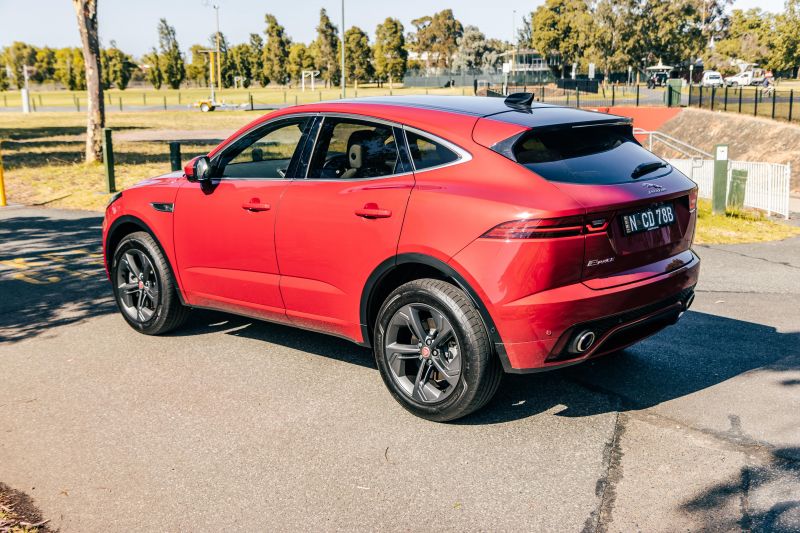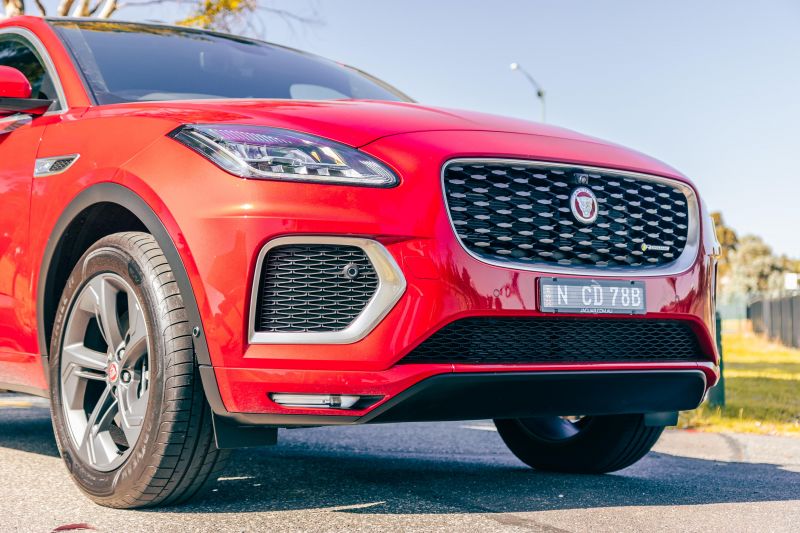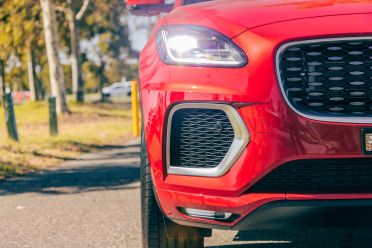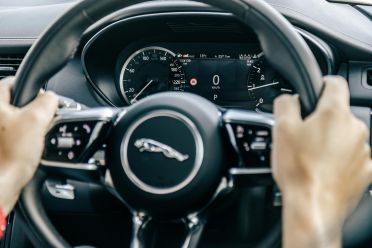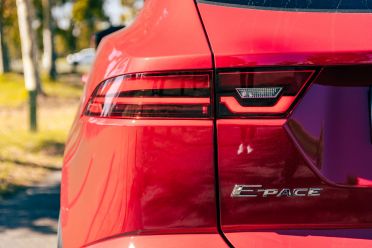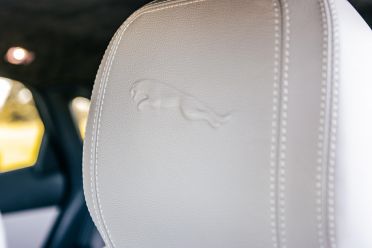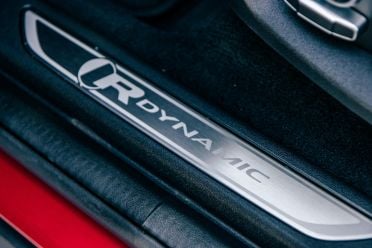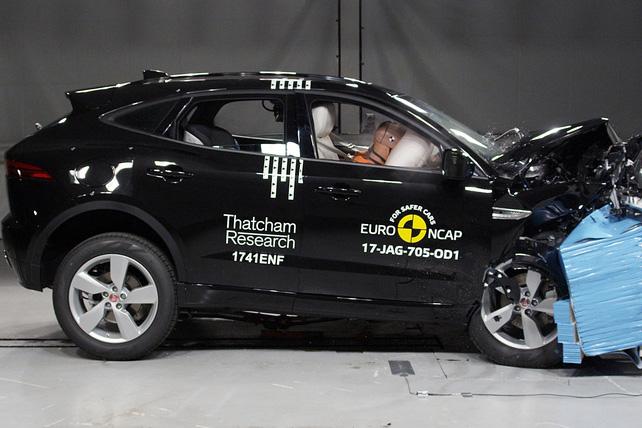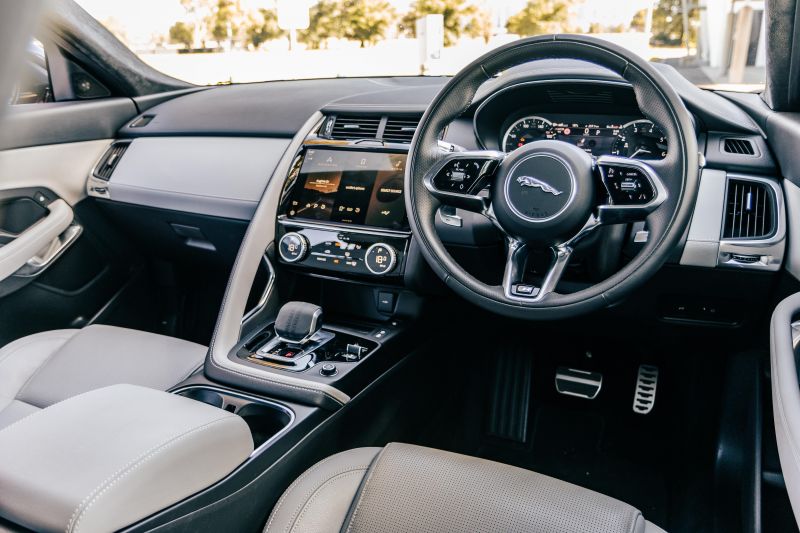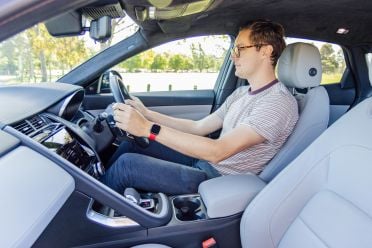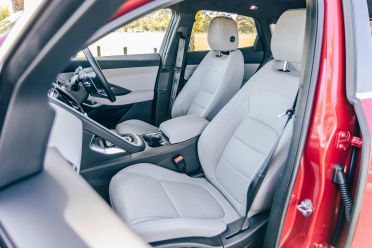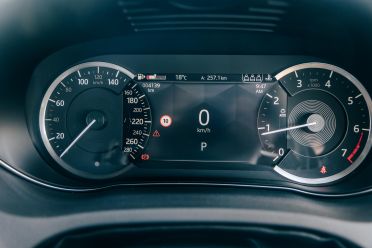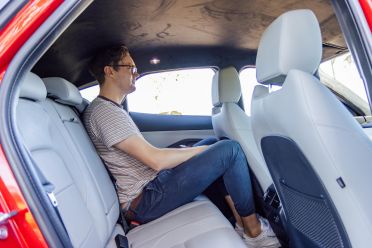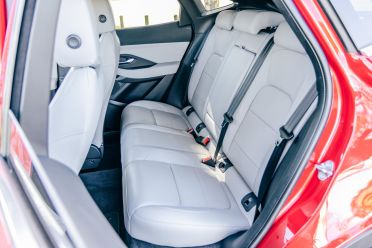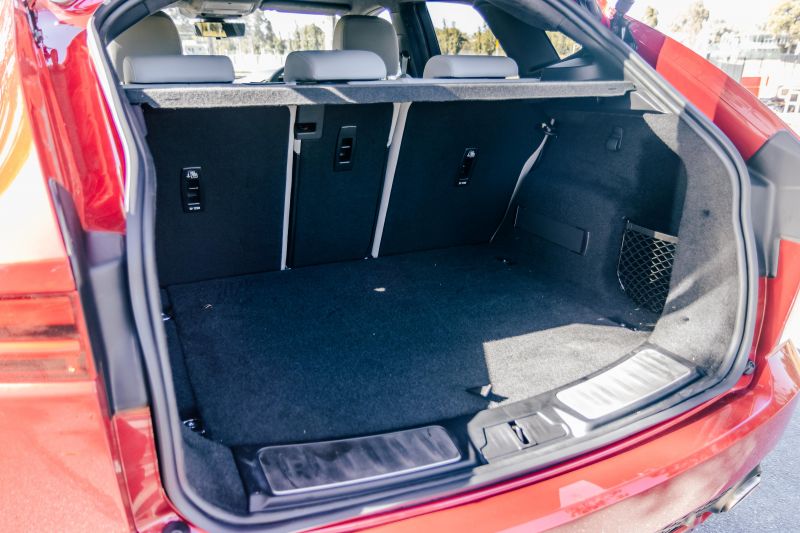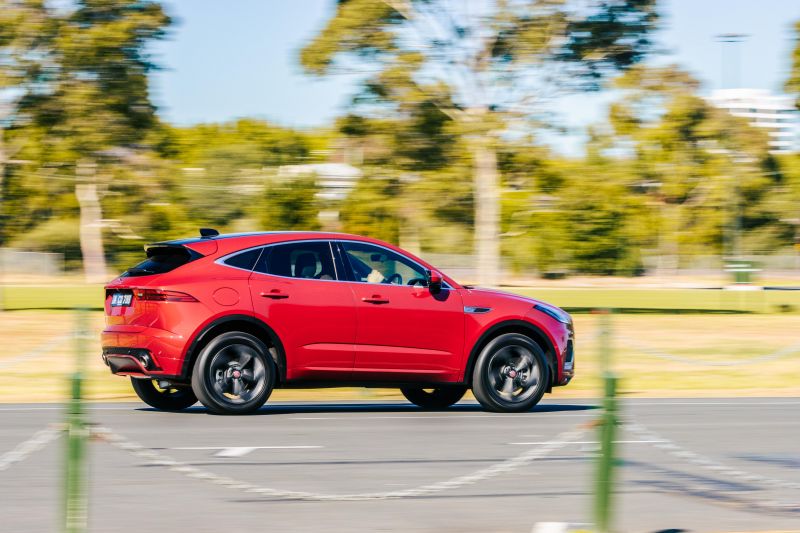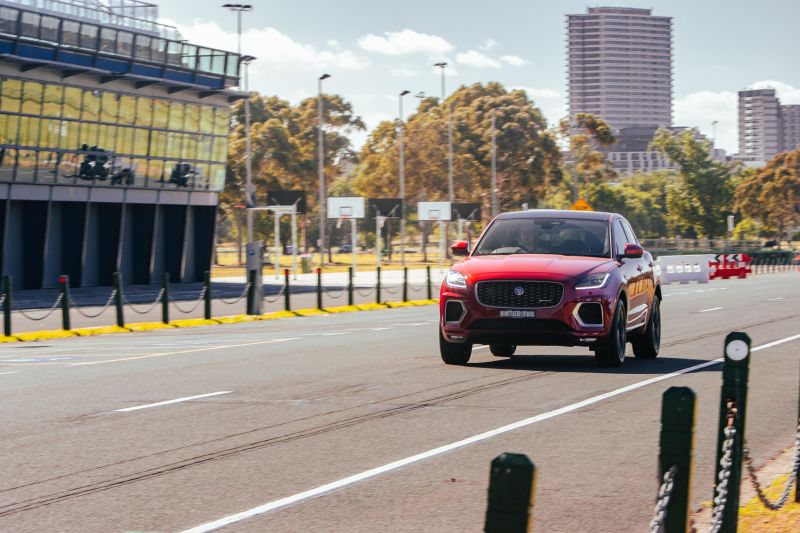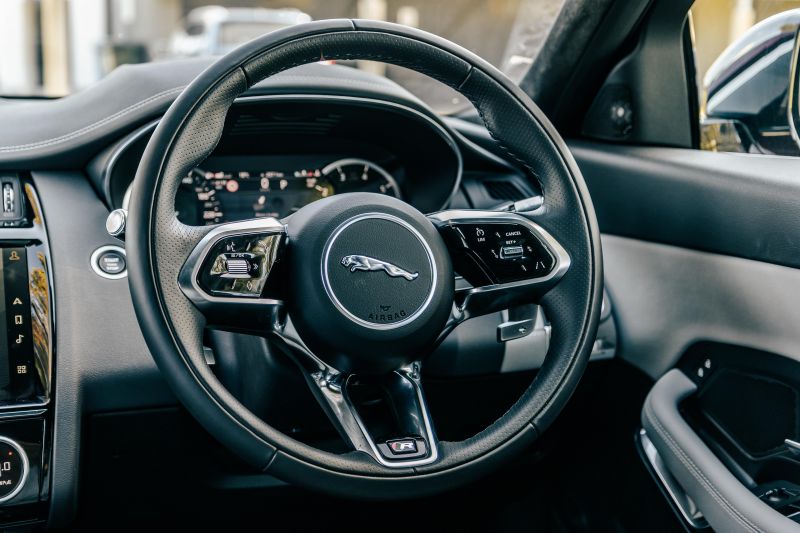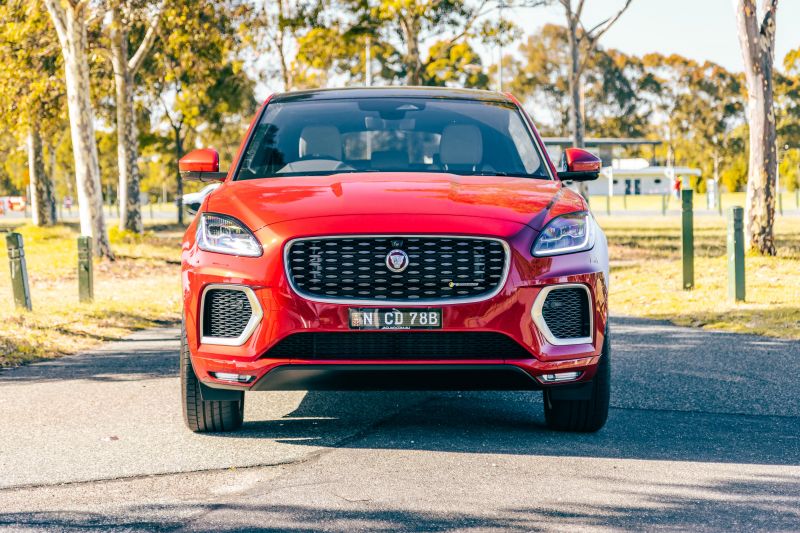Jaguar was late to the crossover party. BMW debuted the X5 before the turn of the millennium, Mercedes-Benz evolved the ML into a proper luxury four-wheel drive in 2005, and we know how successful the Range Rover has been.
Jaguar, though, didn’t wade into the SUV world until 2016, and the E-Pace you see here wasn’t revealed until 2017.
Since then it’s been given a major update globally, and has had its range whittled down in Australia. It’s moved from the Ford-derived underpinnings on which it launched to a more modern platform shared with the Range Rover Evoque as well.
The E-Pace hasn’t set the sales charts alight in Australia since launch. Sitting somewhere between the BMW X1 and X3 on paper, it’s designed to translate curvaceous good looks of the F-Type coupe into an SUV body.
You might need to squint a bit, but there is a link between the two in person.
With sharply creased hips, a dramatic windowline, and tail lights that could have been nicked directly from the F-Type, there’s no doubt this is a handsome little crossover. Of course, it needs to be more than that to succeed.
Does the 2022 Jaguar E-Pace P250 R-Dynamic S on test here have the substance to match its considerable style?

How much does the Jaguar E-Pace P250 R-Dynamic S cost?
The E-Pace R-Dynamic S P250 on test has a list price of $68,588 before on-road costs, but Firenze Red paint ($1370), 19-inch alloy wheels ($1050), a digital rear mirror ($980), a black contrast roof ($970), air ionisation ($780), a wireless phone charger ($350), and privacy glass ($690) bumped the price to $74,778 before on-roads.
Based on its list price, the E-Pace bisects smaller vehicles such as the Mercedes-Benz GLA200 ($57,789) and the larger GLC200 ($74,976).
It’s a similar size to the Volvo XC40, but the Swedish SUV petrol range tops out at $56,990 before on-road costs. More expensive plug-in hybrid and pure-electric models are offered, though.
2022 Jaguar E-Pace pricing:
- Jaguar E-Pace P250 R-Dynamic S: $68,588
- Jaguar E-Pace P250 R-Dynamic SE: $71,767
- Jaguar E-Pace R-Dynamic P250 HSE: $76,111
- Jaguar E-Pace 300 Sport: $84,781
All prices exclude on-road costs
What do you get?
E-Pace P250 S highlights:
- 11.4-inch touchscreen infotainment system
- Android Auto and Apple CarPlay
- DAB digital radio
- Power tailgate
- Surround-view camera
- LED headlights
- Keyless entry and start
- Front and rear parking sensors
- Rain-sensing wipers
- Dual-zone climate control
- Bright metal pedals
- Heated, power-folding exterior mirrors
- Leather-wrapped steering wheel
- Leather upholstery
- Metal sill plates
- Six-speaker sound system
- 12-way power front seats
- 18-inch alloy wheels
Options on the E-Pace S include:
- Automatic high-beam: $270
- LED headlights with dynamic indicators: $780
- Digital instrument cluster: $690
Options on the S, SE and HSE include:
- Selectable drive modes: $680
- Adaptive suspension: $1950
- Black exterior pack: $1150
- Illuminated metal sill plates: $820
- Head-up display: $1630
- Dynamic Handling Pack: $2630
- Adaptive suspension
- Selectable drive modes
- Red brake calipers
- Premium Upgrade Interior Pack: $1590
- Illuminated sill plates
- Premium cabin lighting
- Cabin air purifier
- Technology Pack: $2360 ($2910 on S)
- ClearSight rear-view mirror
- Wireless phone charging
- Head-up display
- Digital instrument cluster
Is the Jaguar E-Pace P250 R-Dynamic S safe?
The Jaguar E-Pace wears a five-star ANCAP safety rating with 2017 date stamp.
The rating was based on an adult occupant protection score of 86 per cent, a child occupant protection score of 87 per cent, a pedestrian protection score of 77 per cent and a safety assist score of 72 per cent.
All 2021 Jaguar E-Pace models come standard with the following safety features:
- Autonomous emergency braking
- Blind-spot monitoring
- Lane-keep assist
- Rear cross-traffic alert
- Traffic sign recognition
- Front, front-side and curtain airbags
- Adaptive speed limiter
- Driver attention monitoring
What is the Jaguar E-Pace P250 R-Dynamic S like on the inside?
That’s better! The pre-update E-Pace was a bit light on wow factor, but the two-tone trim, massive touchscreen, and shiny trim highlights in our tester made it feel far more upmarket.
The sloping grab handle and high-set air vents look as though they’ve been nicked from the F-Type, which is also a nice touch.
The driver and passenger sit in plush armchairs offering a decent view of the road ahead, with enough adjustment to accomodate a broad range of body shapes. The E-Pace strikes a good balance between offering a sporty, Jaguar-ish seating position and a commanding, SUV-ish view out.
It’s a shame the front seats aren’t heated though, and the upper backrest on the driver’s seat in our car was creaky.
The Pivi infotainment system in the E-Pace is a huge step forward from the Touch Pro setup in the pre-update model, and makes the car feel properly modern. It starts up as your bum is hitting the seat, and the graphics feel properly up-to-date.
All the menus are logically laid-out, and Apple CarPlay is brilliant to use on the high-resolution 11.4-inch screen. Jaguar Land Rover was at one point a technology laggard, but it’s really lifted its game lately. A fully digital instrument cluster is optional in the place of the analogue/digital hybrid on the base E-Pace.
Sure, it still has mapping and a range of trip computer options, but it doesn’t look nearly as upmarket as the Virtual Cockpit you can get in the cheaper Audi Q2.
Although they’re better-looking and better to use than what was there previously, the climate controls at the base of the dash also lack the tactility of what’s on offer elsewhere in the premium segment.
There’s acres of storage space up front. The (optional) wireless phone charger sits beneath the sloping dashboard, and you could fit a full-sized laptop or oversized tablet in the underarm storage bin. The cupholders can be removed to free up even more space, and there’s room for big bottles in the door bins.
Things aren’t so rosy in the rear. Headroom is tight because of the sloping, sporty roofline, and legroom is poor with full-sized adults in the front. Our normal-sized photographer commented on how tight the back felt, and called out how small the door aperture is compared to other compact or mid-sized SUVs.
It holds up okay against cars like the Audi Q2 or BMW X1 in the rear, but the Volvo XC40 has it covered for rear-seat space, and there’s no contest with the mid-sized SUVs the E-Pace is approaching in size and price.
The rising belt line doesn’t do outward visibility any favours, and the chunky C-pillar limits over-the-shoulder vision.
At least there are air vents and a fold-down central armrest, along with map pockets on the front seatbacks. You get ISOFIX points on the outboard rear seats, and three top-tether anchors for child seats back there.
You get a claimed 601 litres of boot space with the second row in place and 1386L with it folded, which feels optimistic to say the least. Realistically it’s an acceptably-sized space for a car like the E-Pace, but nothing standout.
The 40/20/40 rear bench means you can carry long items more easily, which is a tick for practicality, but the fixed luggage cover (rather than a sliding cover or a hatch-style unit that lifts with the boot) is painfully cheap.
A set of golf clubs will fit with the driver still in the bag, and the floor is flat for easy loading.
What’s under the bonnet?
The 2022 Jaguar E-Pace P250 is powered by a turbocharged 2.0-litre four-cylinder engine producing 183kW of power and 365Nm of torque.
The whole range comes standard with all-wheel drive and a nine-speed automatic transmission, and has a claimed 100km/h sprint time of 7.5 seconds.
Claimed fuel economy is 7.8 litres per 100km on the combined cycle, but we saw closer to 10.5 litres in the city. The fuel tank holds 67 litres, and the car drinks 95 RON premium unleaded.
How does the Jaguar E-Pace P250 R-Dynamic S drive?
The E-Pace isn’t a big car, but it drives like one – for better and worse.
On the plus side, it’s comfortable to drive around the city. The base model doesn’t get fancy adaptive dampers, and it rides on 18-inch alloy wheels, but the ride is impressive over pockmarked urban streets. It smooths out little pimples and imperfections well.
It feels planted on the highway, and backs its comfortable ride with decent body control. It settles quickly over crests and dips, and isn’t flustered by crosswinds or buffeted by trucks. The adaptive cruise control system does well keeping a gap with the car in front, and the lane-keep assist only gets involved when it really needs to.
If you’re spending a long time on the open road, the E-Pace feels right at home. Unlike in some of its German compact rivals, you don’t need to crank up the stereo to drown out tyre noise on Australian backroads.
Power from the 2.0-litre turbocharged petrol engine is decent, although with almost 1800kg to haul around it’s not what you’d call a firecracker.
Peak torque comes on tap at just 1300rpm and hangs around until 4500rpm, so there’s plenty of shove when you squeeze the accelerator on the move. It pulls smoothly from low in the rev range when you step on the right-hand pedal, and is happy enough to hang onto gears through its 5500rpm power peak and to the redline.
There’s a muted growl in the cabin when you get a move on, but not much more.
The nine-speed automatic is a reasonable partner for the engine, but it feels a bit indecisive at times. Occasionally it kicks down when you don’t need a lower gear, and sometimes it decides not to change down when it really should.
For the most part it shifts unobtrusively, but you can catch it on the hop. Likewise the automatic start/stop system, which lacks the polish of the 48V mild-hybrid systems being rolled out across much of the Jaguar Land Rover range. The engine cuts out more sharply in the E-Pace, and it doesn’t fire quite as quickly – the system is best turned off.
Given it’s been designed to look like an F-Type, you could be fooled into thinking the E-Pace will put the sports into sports utility vehicle. Although it handles better than you might expect, the near-1800kg kerb weight means it can’t quite pull that off.
The front end is surprisingly keen to go when you flick the car into a corner, and it hangs on gamely. It just can’t quite hide its bulk.
With that said, the idea of an E-Pace SVR with a supercharged V8 engine under the bonnet has promise…
How much does the Jaguar E-Pace P250 R-Dynamic S cost to run?
The Jaguar E-Pace is backed by a five-year, unlimited-kilometre warranty, and comes with five years of roadside assist.
A prepaid five-year/102,000km service plan will set you back $1950.
CarExpert’s Take on the Jaguar E-Pace P250 R-Dynamic S
The E-Pace is still a bit of an awkward size and price.
It’s slightly bigger and more expensive than the compact SUV crowd, but it’s not significantly more practical. It’s slightly smaller and sportier-looking than proper mid-sizers, but it’s not significantly sportier to drive.
That’s not to say it’s without appeal. Jaguar has done a good job taking what was a slightly underwhelming car and making it more attractive on the outside, and more modern on the inside.
A mid-range SE model with a slightly fuller equipment list probably makes more sense than our base model if the F-Type-inspired looks catch your eye.
Click the images for the full gallery
MORE: Everything Jaguar E-Pace





